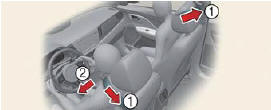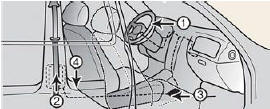Kia Sportage: Pre-tensioner seat belt
Your vehicle is equipped with driver's and front passenger's pre-tensioner seat belts (retractor pre-tensioner and EFD (Emergency Fastening Device)).
 The pre-tensioner
seat belts may be
activated, when a frontal collision is
severe enough, together with the air
bags.
The pre-tensioner
seat belts may be
activated, when a frontal collision is
severe enough, together with the air
bags.
When the vehicle stops suddenly, or if the occupant tries to lean forward too quickly, the seat belt retractor may lock into position. In certain frontal collisions, the pre-tensioner will activate and pull the seat belt into tighter contact against the occupant's body.
- Retractor Pre-tensioner
The purpose of the retractor pre-tensioner is to make sure that the shoulder belts fit in tightly against the occupant's upper body in certain frontal collisions.
- EFD (Emergency Fastening Device)
The purpose of the EFD is to make sure that the pelvis belts fit in tightly against the occupant's lower body in certain frontal collisions.
If the system senses excessive tension on the driver or passenger's seat belt when the pre-tensioner system activates, the load limiter inside the retractor pre-tensioner will release some of the pressure on the affected seat belt.
NOTICE
When the pre-tensioner seat belts are activated, a loud noise may be heard and fine dust, which may appear to be smoke, may be visible in the passenger compartment. These are normal operating conditions and are not hazardous.
The seat belt pre-tensioner system consists mainly of the following components.
Their locations are shown in the
illustration: 
* The actual position of seat belt pre-tensioner system components may differ from the illustration.
- SRS air bag warning light
- Retractor pre-tensioner assembly
- SRS control module
- Emergency fastening device (EFD)
WARNING
Skin Irritation
Wash all exposed skin areas thoroughly after an accident in which the pre-tensioner seat belts were activated. The fine dust from the pre-tensioner activation may cause skin irritation and should not be inhaled for prolonged periods.
NOTICE
- Both the driver's and front passenger's seat belt pre-tensioner systems may be activated not only in certain frontal collisions, but also in certain side collisions or rollovers, if the vehicle is equipped with a side or curtain air bag.
- Because the sensor that activates the
SRS air bag is connected with the pretensioner
seat belt, the SRS air bag
warning light
 on the instrument
panel will appear for approximately 6
seconds after the ignition switch has
been turned to the ON position, and
then it should turn off.
on the instrument
panel will appear for approximately 6
seconds after the ignition switch has
been turned to the ON position, and
then it should turn off. - If the pre-tensioner seat belt system is not working properly, this warning light will appear even if there is not a malfunction with the SRS air bag. If the SRS air bag warning light does not appear when the ignition switch has been turned to the ON position, or if it remains appeard after illuminating for approximately 6 seconds, or if it appears while the vehicle is being driven, have an authorized Kia dealer inspect the pre-tensioner seat belt and SRS air bag system as soon as possible.
NOTICE
Do not attempt to service or repair the pre-tensioner seat belt system in any manner. Do not attempt to inspect or replace the pre-tensioner seat belts yourself. This must be done by an authorized Kia dealer.
WARNING
Hot pre-tensioner
Do not touch the pre-tensioner seat belt assemblies for several minutes after they have been activated. When the pretensioner seat belt mechanism fires during a collision the pre-tensioner becomes hot and can burn you.
Pre-tensioners are designed to operate only one time. After activation, pre-tensioner seat belts must be replaced. If the pre-tensioner must be replaced, contact an authorized Kia dealer.
READ NEXT:
 Seat belt precautions
Seat belt precautions
Take the following precautions when
using seat belts.
Infant or small child
All 50 states have child restraint laws.
You should be aware of the specific
requirements in your state. Child and/or
 Children always in the rear
Children always in the rear
Infants and younger children must be
restrained in an appropriate rear-facing
or forward-facing Child Restraint System
(CRS) that has first been properly
secured to the rear seat of the vehicle.
SEE MORE:
 Repair procedures | Canister
Repair procedures | Canister
Inspection
[System Inspection]
1. Disconnect the vapor hose from the intake manifold and connect a vacuum pump to the nipple on the intake manifold.
At Cold Engine [Engine Coolant Temperature < 60ºC(140ºF) ]
2. Check the following points with applied vacuum at the purge con
 Components and Components Location | Relay Box (Engine Compartment)
Components and Components Location | Relay Box (Engine Compartment)
Component Location
[Engine Room Relay Box]
Main relay
Cooling fan relay (High)
Windshield deicer relay
Wiper relay (High)
Wiper relay (Low)
ATM relay
Rear glass defogger relay
Burglar horn relay
Start relay
Cooling fan relay (Low)
Hor
Content
- Home
- Kia Sportage - Fifth generation (NQ5) - (2022-2025) - Owner's Manual
- Kia Sportage - Second generation (JEKM) (2005-2015) - Body Workshop Manual
- Kia Sportage Third generation (SL) - (2011-2016) - Service and Repair Manual
- Sitemap
- Top articles